The Entrance Matting Market is estimated to be valued at USD 7.7 billion in 2025 and is projected to reach USD 13.6 billion by 2035, registering a compound annual growth rate (CAGR) of 5.7% over the forecast period.
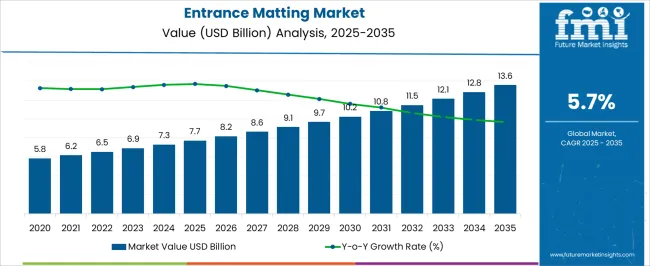
| Metric | Value |
|---|---|
| Entrance Matting Market Estimated Value in (2025 E) | USD 7.7 billion |
| Entrance Matting Market Forecast Value in (2035 F) | USD 13.6 billion |
| Forecast CAGR (2025 to 2035) | 5.7% |
The entrance matting market is expanding steadily, driven by the rising emphasis on cleanliness, safety, and aesthetic appeal in commercial and residential infrastructure. Demand is reinforced by the role of matting systems in preventing dirt, moisture, and debris from entering indoor spaces, thereby reducing maintenance costs and enhancing safety.
The current market reflects growing investments in hospitality, retail, healthcare, and corporate facilities, where high-traffic areas require durable and functional matting solutions. Manufacturers are focusing on eco-friendly materials, modular designs, and enhanced durability to cater to evolving consumer and regulatory preferences.
With global construction and urban development continuing at pace, entrance matting adoption is projected to grow consistently, supported by both functional requirements and design considerations.
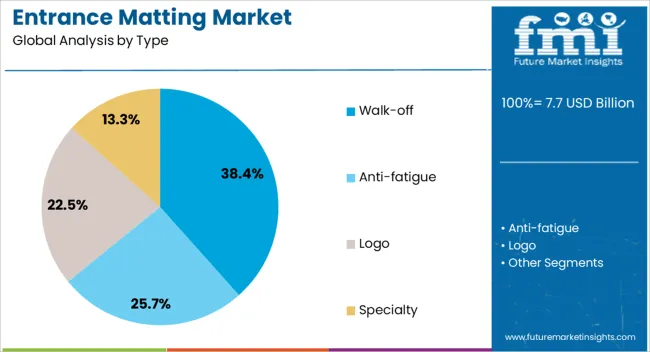
The walk-off segment dominates the type category, accounting for approximately 38.4% share of the entrance matting market. Its leadership is attributed to its effectiveness in capturing dirt and moisture at entry points, reducing cleaning and maintenance expenses for facility operators.
Walk-off mats are widely adopted across commercial buildings, retail centers, and healthcare facilities due to their durability and functionality in high-traffic environments. Design variations, including modular and customizable options, have further boosted adoption.
With increasing demand for solutions that enhance both safety and indoor hygiene, the walk-off segment is expected to sustain its dominant share.
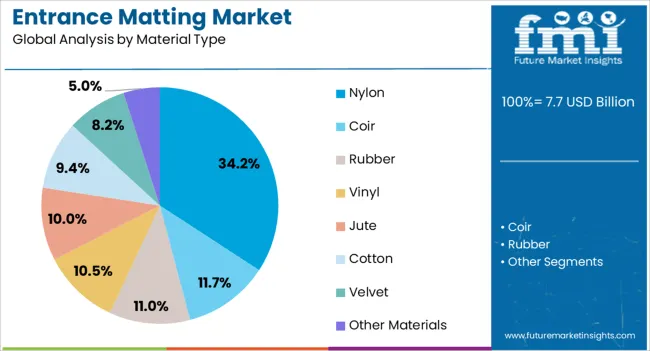
The nylon segment leads the material type category, representing approximately 34.2% share in the entrance matting market. This dominance is supported by nylon’s high durability, moisture absorption capacity, and ability to withstand heavy foot traffic.
Its resilience and aesthetic versatility make it suitable for a wide range of applications, from corporate buildings to retail facilities. Manufacturers favor nylon for its cost-effectiveness and adaptability in producing mats with varied designs and textures.
The segment has further benefited from sustainability initiatives, with recycled nylon options gaining traction. With consistent demand for durable and functional matting, nylon is expected to remain the material of choice.
The commercial segment holds approximately 29.7% share of the application category, reflecting its primary role as the largest user of entrance matting systems. Commercial facilities, including offices, malls, hotels, and healthcare institutions, require robust matting solutions to manage high pedestrian volumes and maintain hygiene standards.
The segment benefits from regulatory emphasis on workplace safety and the cost-saving advantages of reduced cleaning frequency.
With ongoing global investments in commercial real estate and infrastructure, the demand for entrance matting in this segment is expected to expand, ensuring its continued dominance.
The global entrance matting market was valued at USD 5.8 billion in 2020. From 2020 to 2025, the market progressed at a CAGR of 7.5% and reached a valuation of USD 7.7 billion by 2025. Innovations in materials and designs in response to pandemic-related challenges were the breakthroughs that propelled the market during this period.
| Attributes | Details |
|---|---|
| Entrance Matting Market Size (2020) | USD 5.8 billion |
| Historical Market Value (2025) | USD 7.7 billion |
| HCAGR (2020 to 2025) | 7.5% CAGR |
The rising safety regulations have increased the use and demand for different types of sanitary equipment, including entrance matting. So, producers of entrance mats with improved safety features, including ergonomic designs and slip resistance, are witnessing greater traction in recent years.
Entry matting is in high demand due to stringent workplace safety rules, serving as a preventive measure against slips and falls. Further strengthening of workplace safety rules is expected to play a crucial role in driving market expansion.
Many businesses and corporations are adopting custom logo floor mats as a product that offers potential for branding and advertising. So, entryway mat manufacturers that provide customization choices, such as bespoke logos and branding features, can draw in more commercial entities. Such customers want to improve their business's perception as soon as potential customers walk through the door.
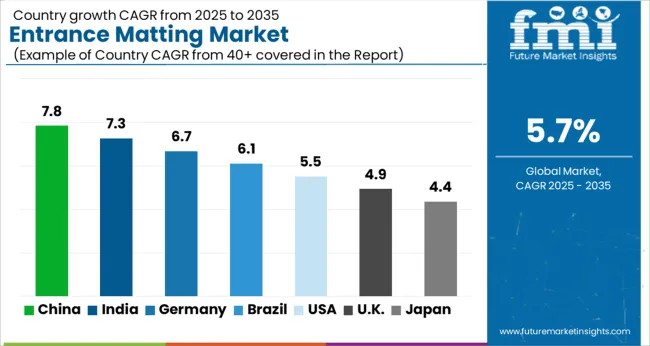
The table below lists the expected growth rates for major markets through 2035.
Sales of entrance matting products in the United States are expected to rise at 6.1% CAGR from 2025 to 2035.
The demand for entrance mats is expected to increase in the United Kingdom at a 7% CAGR through 2035.
The entrance matting industry in China is likely to witness a CAGR of 6.5% through 2035.
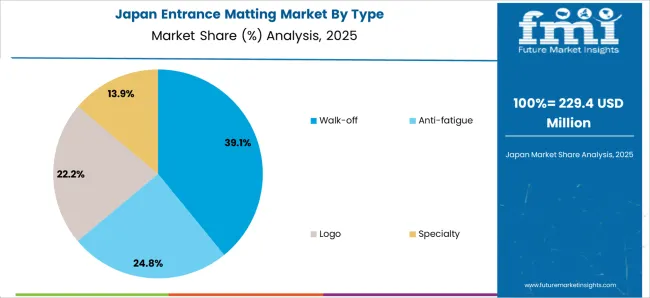
The demand for entrance matting is expected to increase at a 7.6% compound annual growth rate (CAGR) through 2035.
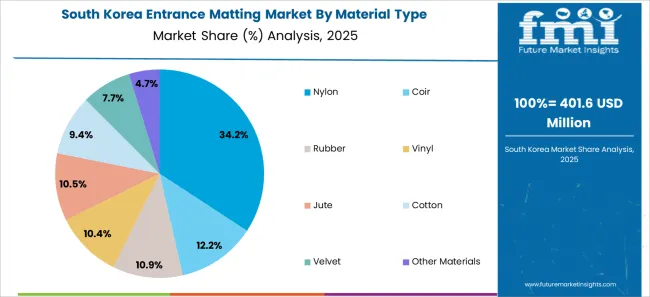
The South Korean market is poised to grow at a compound annual growth rate (CAGR) of 8.1% from 2025 to 2035.
Based on the product type, walk-off entrance mattings account for a greater market share. During the forecasted years, the size of the walk-off entrance mat segment is likely to expand at a CAGR of 5.6% through 2035.
| Attributes | Details |
|---|---|
| Top Type | Walk-off |
| CAGR (2025 to 2035) | 5.6% |
| CAGR (2020 to 2025) | 7.3% |
Based on the material used, the nylon entrance mattings are expected to lead the market. Sales of nylon entrance mats are projected to rise at a CAGR of 7.1% from 2025 to 2035.
| Attributes | Details |
|---|---|
| Top Material Type | Nylon |
| CAGR (2025 to 2035) | 5.4% |
| CAGR (2020 to 2025) | 7.1% |
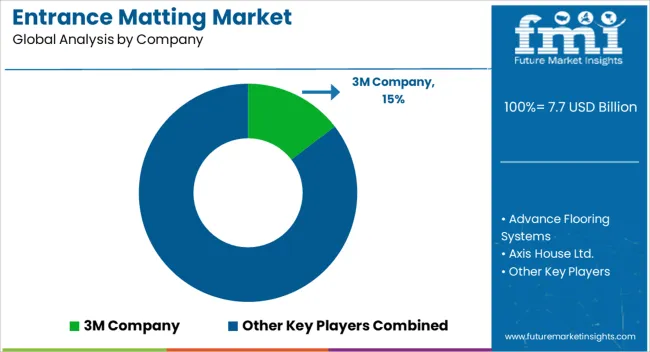
The global market is highly competitive as there are many entrance matting manufacturers operating at different levels. The market competition is expected to increase in the coming days with the entry of new players with innovative materials and new designs.
Leading market players have established themselves as dependable providers by guaranteeing that their mats meet or surpass industry safety requirements. On the other hand, new players appeal to environmentally aware customers and companies by using sustainable fibers or recycled materials in their entrance mats.
Recent Developments in the Global Entrance Matting Market
| Attribute | Details |
|---|---|
| Estimated Market Size (2025) | USD 7.3 billion |
| Projected Market Size (2035) | USD 12.8 billion |
| Anticipated CAGR (2025 to 2035) | 5.8% |
| Forecast Period | 2025 to 2035 |
| Historical Data Available for | 2020 to 2025 |
| Market Analysis | USD million or billion for Value and Units for Volume |
| Key Regions Covered | North America; Latin America; Europe; Middle East & Africa (MEA); East Asia; South Asia and Oceania |
| Key Countries Covered | United States, Canada, Brazil, Mexico, Germany, Spain, Italy, France, United Kingdom, Russia, China, India, Australia & New Zealand, GCC Countries, and South Africa |
| Key Segments Covered | By Type, By Application, By Material Type, By Utility, and By Region |
| Key Companies Profiled | 3M Company; Advance Flooring Systems; Axis House Ltd.; Birrus Mating Systems |
| Report Coverage | Market Forecast, Company Share Analysis, Competition Intelligence, DROT Analysis, Market Dynamics and Challenges, and Strategic Growth Initiatives |
| Customization & Pricing | Available upon Request |
The global entrance matting market is estimated to be valued at USD 7.7 billion in 2025.
The market size for the entrance matting market is projected to reach USD 13.6 billion by 2035.
The entrance matting market is expected to grow at a 5.7% CAGR between 2025 and 2035.
The key product types in entrance matting market are walk-off, anti-fatigue, logo and specialty.
In terms of material type, nylon segment to command 34.2% share in the entrance matting market in 2025.






Full Research Suite comprises of:
Market outlook & trends analysis
Interviews & case studies
Strategic recommendations
Vendor profiles & capabilities analysis
5-year forecasts
8 regions and 60+ country-level data splits
Market segment data splits
12 months of continuous data updates
DELIVERED AS:
PDF EXCEL ONLINE
Matting Agents Market Size and Share Forecast Outlook 2025 to 2035
ESD Safe Matting Market Size and Share Forecast Outlook 2025 to 2035

Thank you!
You will receive an email from our Business Development Manager. Please be sure to check your SPAM/JUNK folder too.
Chat With
MaRIA